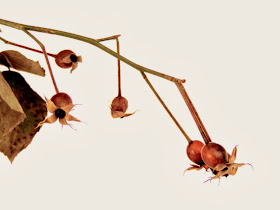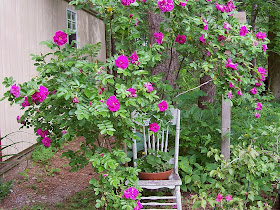 |
| Winter Solitude |
Loneliness expresses the pain of being alone
and solitude expresses the glory of being alone.
-Paul Tillich
We had a mid-week temperature of minus 22F in the morning and the plants are protecting themselves. At least we weren't as cold as Watertown, New York - they were minus 37F on January 22, 2014. They were coldest city for that day in the lower 48 States: Watertown's Wild Winter. We're about 25 miles south of Watertown. If you missed my blog post on the ice storm in the Watertown area before Christmas you can check it out here: Welcoming in 2014!
Do you recognize this shrub? It is a rhododendron. It almost looks like it's dying with the leaves all curled up like that. In winter when the temperatures drop below freezing, certain shrubs protect themselves by curling their leaves in to reduce the surface area that is exposed to the cold. This also makes a more humid area inside the leaf. Rhododendrons that are grown in the shade usually have a larger and longer leaf to gather more light and if they are grown in the sun the leaves are somewhat smaller and thicker to retain moisture.
Here is your word for the day: Thermonasty. As a matter of fact I knew there was a word for this occurrence of the leaves curling inward to protect the plant, but I couldn't remember the term so I had to look it up online. Basically it means the response to a change of temperature. If you are interested in additional scientific information on thermonasty you can click on the link: http://journal.ashspublications.org/content/133/6/768.full
 |
| Temperatures below freezing (32F degrees) and this is what the leaves will look like on a rhododendron. |
 |
| This is the same rhododendron in winter as in above two photos but temperatures above freezing (32F degrees). |
 |
| Same rhododendron in early June (leaves are fully extended) |
If you planted shrubs and perennials that were recommended for your hardiness zone (USDA Plant Hardiness Zones) you should not experience much damage from the cold temperatures to your plants. But that's not always the case. Sometimes winter-kill also occurs.
Winter-kill: Sometimes a tree, shrub or perennial might be damaged by winter-kill. This can happen in the fall when the temperatures drop too fast early in the season and the plant has not acclimated to the colder temperatures. It can also occur during winter dormancy, or in or in the spring after the plant is coming out of dormancy.
It's possible that your plant was already stressed from last year's growing season if it was a particularly dry season. In winter when it's very cold, if the ground is frozen the plant can not take up water and the leaves will dry out and turn brown. Add wind to the problem and that can cause major problems for your trees and shrubs. In our area of New York we are fortunate in that we usually have significant snowfall which helps to protect and insulate our plantings. Where there is no snow on the ground and you have very cold temperatures your plants are more susceptible to winter-kill.
 |
| A very old trumpet vine |
 |
| Clematis vine on small trellis |
In late winter or early spring when you are able to get back out into your garden, check your plants to see if the frost has heaved any of your perennials out of the ground. I've had this happen to irises and heuchera (coral bells), and other perennials. If you find that this has happened to some of your plants put a rock on them to keep them from getting further pushed out of the ground until you can re-plant them deeper into the soil.
If you notice that a plant is not growing in spring and you suspect damage from winter, do not dig it up right away or discard it. Sometimes it takes a few months for them to rejuvenate and start growing again.
 |
| Rugosa Rose hips in winter. |
Be careful handling the shrub because the stems have thorns growing up all the stems. The thorns are close together and can be brutal. Plant it in an area away from foot traffic. I really love this rose because it reminds me of the old-fashioned roses with it's strong scented flowers. Not all of them are scented and its also is available in other colors. It is cold hardy for zones 3-9.
 |
| Rugosa Rose in summer |
 |
| Tall Sedum (Autumn Joy) photo taken October 2013 |
Note: Ted (my husband) is keeping busy this winter. Second New Birdhouse!!! If you didn't get a chance to read my last post on birdhouses here is the link for it: Birdhouses - Think Spring!
Feel free to leave a comment. . .I would love to hear from you!
















